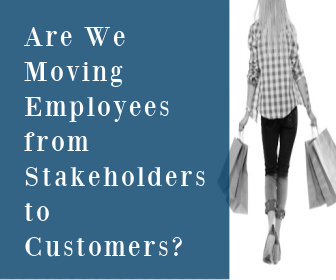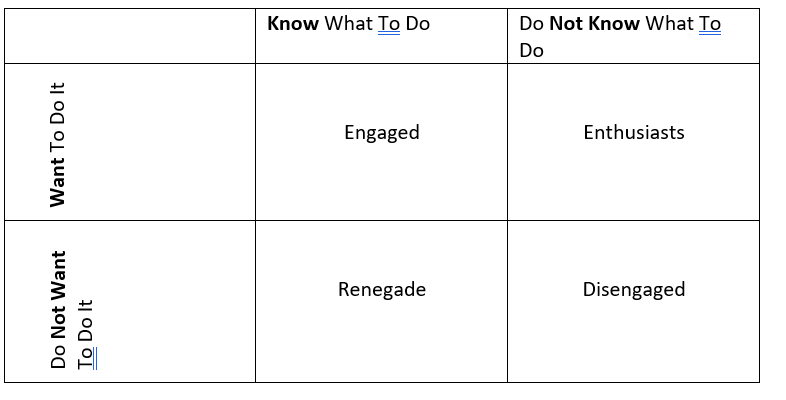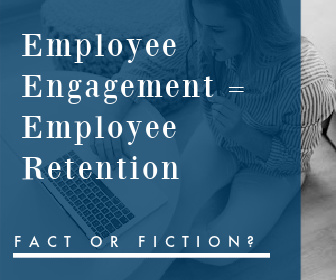Employee Retention Part 3: Are We Moving Employees from Stakeholders to Customers? | A Workplace Blog
Beth Schaefer – IPD Director
Note: This is the third blog in the Employee Engagement Series.
The first article looked at the origin of the Employee Engagement theory, and the second article defined the concept.
During this ongoing time of The Great Resignation, have your staff and employees moved from being stakeholders in the work of the organization to being customers of your organization?
I mean becoming customers in the sense that their voice is becoming a stronger and stronger consideration and factor in how you do business and structure your policies and work.
Attracting and retaining employees appears to be a stumbling block to many businesses attempting to return to pre-pandemic levels of building products, managing supply chains, and/or serving customers.
Just in my suburban neighborhood:
- The DQ does not have enough employees to open its indoor service – Even though post-Covid would allow them to open indoor seating, they still offer only drive-thru, and in this heat wave, that line is 20 cars deep. I have yet to get in line.
- The Papa Murphy’s in my neighborhood closes at 6 pm. Correct, no pizza after 6 pm. I seldom get my pizza ordered on time.
- My local pub is no longer open on Sundays and Mondays so that their team can have “a weekend.” I miss Sunday dinners and not having to cook after a day of working in the yard.
- Target had checkout lines 6 deep early on a Sunday morning and many empty shelves. For the past month, I have been trying to purchase legal pads only to find the shelf empty. And, I admit, when they were finally there, I hoarded and took 3 instead of just the 1 I needed at the moment.
- Help Wanted signs, banners, and flyers are on pretty much every large and small business in my suburb. Yes, I am considering a side hack to add some extra income…
I am sure that you also have examples of supply chain shortages, shorter hours, and longer lines due to an employee shortage.
This is not just a dilemma for retail and hospitality, I know from talking with friends, family, and coworkers that many are burned out in their roles in teaching and child care, healthcare, IT, and marketing as they continue to cover for unfilled positions for many months at a time. Taking a vacation requires planning months before you depart and a month of catch-up when you return.
These shortages have many employers rethinking what they can offer employees. At some point, the hourly pay or weekly salary rate may not be enough; you need to have something extra special to retain talent – is that something extra special in Employee Engagement?
If you have not sipped from the cup of Employee Engagement yet, this may be your time to give it a try. Here is a starter kit from the experts with notes from me.
-
70% of the most effective employee engagement occurs with the immediate supervisor. If you are an immediate supervisor, you can use these ideas to start building employee engagement with your team.
My note: If you manage immediate supervisors, you may want to loop them in with some engagement training or some engagement information or… use these tactics with them to increase their engagement levels…
-
Thank your employees for the work they do. Be specific. Be in the moment. Be real.
My note: To me, this would include publicly praising your team and giving them credit while you take a step back from the spotlight.
-
Communicate as much as you can, as soon as you can, with as much detail as you can about the business, the problems, and the achievements.
My note: I think this demonstrates trust and respect; however, you also need to be respectful of the messaging your organization wants you to send. I am also a fan of well-orchestrated messaging.
-
Bring employees in on problems, listen to them, and foster a solution-centered or solution-focused department and team.
My note: I think this demonstrates trust and respect and helps to create a workplace based on reality, but positive.
-
Keep your promises. Do not promise something you cannot deliver. If you say you are going to do it, do it.
My note: I would add – do it promptly.
-
Create downtime for employees to get to know each other on a personal level. When a crisis occurs, people who care about each other are more likely to pitch in and help one another – whether one person is having a tough day or the whole team is having a tough day or it’s your busy season.
My note: You also need to take time to get to know your team members and staff. I have more to say on this topic, but realize that it needs its article. Look for an upcoming article on The Power of Workplace Chit Chat.
Using Employee Engagement tactics to create an environment where people want to work may be your next best strategy for retaining your people – especially if you cannot afford a salary bidding war.





